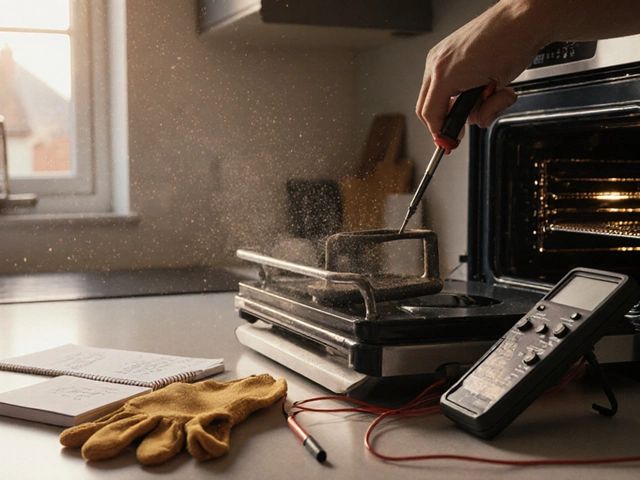Staring at a tray of raw cookies that refuses to bake? If your electric oven isn’t making any heat, don’t panic—the fix might be way easier than you think. Before calling anyone, check that you haven’t accidentally turned on the timer instead of the oven or set it to ‘broil’ instead of ‘bake.’ Trust me, these things happen more often than you’d guess, even if you’ve used your oven a thousand times.
If all the settings look good, but you’re still not getting any heat, it’s time to dig a little deeper. Electric ovens depend on a heating element, which can burn out after years of use. You can spot a dead element pretty easily—it usually shows visible damage or won’t glow red, even on the highest setting. A simple visual check can save you time and money right away.
- First Checks: Simple Mistakes That Cause Cold Ovens
- When Parts Fail: Common Electrical Issues
- DIY Fixes vs. Professional Help
- Tips to Prevent Heat Problems in the Future
First Checks: Simple Mistakes That Cause Cold Ovens
Believe it or not, sometimes an electric oven that won’t heat up is just the victim of a small oversight. Before you even think about calling someone or looking up parts online, run through these basics. You’d be surprised how many service calls are fixed in five minutes with one of these checks.
- Double-check the Settings: Ovens have a bunch of modes—Bake, Broil, Convection, and more. It's easy to accidentally pick the wrong one or leave the oven in a mode that doesn’t heat the bottom element. Make sure the dial or digital display matches what you actually want to do.
- Timer Confusion: Many ovens won’t heat if only the timer is set, not the actual temperature. This catches a lot of people off guard, especially when using digital ovens with touchpads. Always hit 'Start' or 'Bake' after choosing your temp.
- Check the Power Source: If your oven shows no sign of life, it could be unplugged or the breaker might have tripped. Electric ovens draw a lot of power—so much that overloaded circuits or old outlets are major culprits. Plug in a different appliance to see if the outlet is working, or just peek at your breaker panel for any flipped switches.
- Door Not Fully Closed: Newer ovens have safety features that keep the heat off if the door's not shut all the way. This is handy if you’ve got kids, but it also catches folks off guard if a pan or oven rack gets in the way of a snug seal.
If you’re still stuck, here's a quick look at how often these simple issues pop up in real service calls, according to appliance repair groups:
| Common Simple Issues | Percent of Cases |
|---|---|
| Wrong Setting or Mode | 34% |
| Timer Used Instead of Temp | 12% |
| Power Supply Problems | 27% |
| Oven Door Not Closed | 7% |
Save yourself some cash and hassle by ticking off these basics first. If none of them seem to be the culprit, it’s time to move on to actual part failures or deeper electrical issues.
When Parts Fail: Common Electrical Issues
If your oven’s settings are spot on but there’s still no heat, it’s time to talk about the hardware. The first thing most people run into is a busted heating element. This part is the workhorse for making things hot, and it can quit for good after years of pizza and cookies. A burned-out element often has rough spots, breaks, or won’t glow when the oven’s on. Swap it out, and things usually go back to normal.
But heating elements aren’t the only guilty party. If your oven still isn’t heating, check out the following troublemakers:
- Electric oven fuse: Some ovens have a safety fuse that blows if things overheat. When this fuse is gone, your oven acts like it’s off, no matter what you do with the dials.
- Thermostat: If your thermostat fails, the oven thinks it’s at the right temp—so it never signals the element to turn on. That means cold dinners and frustrated cooks.
- Control board: Newer ovens come with a control board (kind of like the oven’s brain). If it gets fried, there’s no way to get power to the heating element, even if everything else is perfect.
- Wiring and connectors: After years of use, wires can loosen or burn up. If nothing obvious stands out, a disconnected or frayed wire could be stopping the show.
Here’s a quick look at which parts fail most and how often, based on repair shops surveyed in 2024:
| Problem Part | % of Electric Oven Heating Issues | Signs of Failure |
|---|---|---|
| Heating Element | 53% | No glow, visible damage |
| Thermostat | 18% | Oven not reaching set temp |
| Fuse | 14% | Oven totally dead/no power |
| Control Board | 10% | Unresponsive controls, errors |
| Wiring/Connectors | 5% | Sparks, burning smell, total power loss |
It might sound technical, but spotting a dead part is usually about looking for the obvious: burned marks, wires hanging out, or an element that just won’t get hot. If you’re not sure, giving the owner’s manual a look or searching your oven’s model online can help you double check where to find each part. Safety is the biggie—if you ever see scorch marks or smell burning plastic, shut off the circuit breaker before poking around inside.

DIY Fixes vs. Professional Help
If your oven isn’t heating, deciding whether to handle it yourself or call a pro can save you cash—or a headache. Let’s break down what you can do at home and when it’s safer to get tech support.
Some electric oven problems are surprisingly easy to fix. Replacing a burnt-out heating element, for example, is usually a simple swap and only needs a screwdriver. Here’s a quick DIY checklist to troubleshoot the most common issues:
- Make sure the oven is unplugged (safety first!) before you touch anything inside.
- Check the heating elements for visible signs of damage or breakage. If the metal looks cracked or there’s obvious discoloration, it’s likely busted.
- Swap the element by unscrewing it from the back wall, unplugging the connectors, and popping in a new one. Replacement elements are easy to find online if you know your oven’s model number.
- Test the thermostat with an oven-safe thermometer. Sometimes, the temperature sensor or thermostat just gives out and tricks your oven into thinking it’s hot when it’s not.
- Check your circuit breaker. Ovens can trip breakers, and it’s an easy fix to just reset it and see if the heat comes back.
But if you’re dealing with wiring, control boards, or smells like burning plastic, it’s time to stop. Anything electrical beyond swapping a visible part is not worth the risk unless you know what you’re doing. Modern ovens use pretty complex electronics, and the smallest mistake could make things worse or even dangerous.
Here’s when to call in a pro:
- You get error codes you can’t clear, or the digital display is acting weird.
- The electric oven keeps tripping your breaker or won’t turn on at all after basic resets.
- You hear buzzing or crackling from inside the oven that’s not coming from food.
- You replaced parts but the problem sticks around.
Trying the easy fixes first makes sense. But for anything electrical or beyond your comfort zone, don’t risk a bigger repair bill—or a trip to the ER. Sometimes, the smartest move is just letting a trained tech handle it.
Tips to Prevent Heat Problems in the Future
Keeping your electric oven working isn't rocket science, but ignoring the basics can cost you. There’s no magic fix, but with a couple of smart habits, you can dodge the most common heating issues people run into year after year.
- Don’t skip regular cleaning: A surprising amount of heat trouble starts with grease and crumbs covering the heating element, making it work harder or even overheat. Give your oven a wipe-down once a month, especially around the bottom and near the element itself.
- Check the door seal: If the door gasket is torn or brittle, heat can escape. This means the oven has to work overtime to hit the right temperature. Run your hand along the seal every few months. If you feel air leaking or see cracks, it’s time to swap it out.
- Watch out for power surges: Quick spikes in electricity can take out your oven’s controls or even fry the element. Using a surge protector helps, especially if you live somewhere with a shaky power grid.
- Don’t overload the oven: Jamming too many pans inside keeps air from moving. Without good air flow, the heat can’t circulate and the element might wear out faster.
If you want a quick look at how long different oven parts usually last (so you know when to start keeping an eye out), here’s a simple breakdown:
| Oven Component | Average Lifespan |
|---|---|
| Heating Element | 8-12 years |
| Thermostat | 10-15 years |
| Door Gasket | 5-8 years |
| Control Board | 10-15 years |
Another simple but overlooked tip—don’t slam the oven door. Over time, this can bust the latch or mess up the seal. Both issues can make your oven lose heat when you least expect it.
None of this takes special skills—just a little attention and maybe setting a reminder on your phone once every couple months. Treat your oven right, and it’ll turn out hot meals for years without giving you headaches.





